Direct submissions to PCI Ecology from bioRxiv.org are possible using the B2J service
Latest recommendations

| Id | Title * | Authors * | Abstract * | Picture * | Thematic fields * | Recommender | Reviewers | Submission date | |
|---|---|---|---|---|---|---|---|---|---|
10 Oct 2024
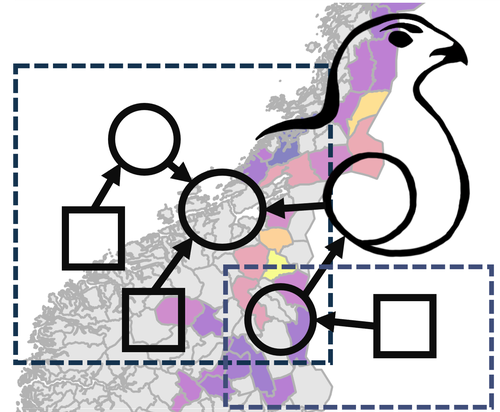
Large-scale spatio-temporal variation in vital rates and population dynamics of an alpine birdChloé R. Nater, Francesco Frassinelli, James A. Martin, Erlend B. Nilsen https://doi.org/10.32942/X2VP6JDo look up: building a comprehensive view of population dynamics from small scale observation through citizen scienceRecommended by Aidan Jonathan Mark Hewison based on reviews by Todd Arnold and 1 anonymous reviewerPopulation ecologists are in the business of decrypting the drivers of variation in the abundance of organisms across space and time (Begon et al. 1986). Comprehensive studies of wild vertebrate populations which provide the necessary information on variations in vital rates in relation to environmental conditions to construct informative models of large-scale population dynamics are rare, ostensibly because of the huge effort required to monitor individuals across ecological contexts and over generations. In this current aim, Nater et al. (2024) are leading the way forward by combining distance sampling data collected through a large-scale citizen science (Fraisl et al. 2022) programme in Norway with state-of-the-art modelling approaches to build a comprehensive overview of the population dynamics of willow ptarmigan. Their work enhances our fundamental understanding of this system and provides evidence-based tools to improve its management (Williams et al. 2002). Even better, they are working for the common good, by providing an open-source workflow that should enable ecologists and managers together to predict what will happen to their favourite model organism when the planet throws its next curve ball. In the case of the ptarmigan, for example, it seems that the impact of climate change on their population dynamics will differ across the species’ distributional range, with a slower pace of life (sensu Stearns 1983) at higher latitudes and altitudes. On a personal note, I have often mused whether citizen science, with its inherent limits and biases, was just another sticking plaster over the ever-deeper cuts in the research budgets to finance long-term ecological research. Here, Nater et al. are doing well to convince me that we would be foolish to ignore such opportunities, particularly when citizens are engaged, motivated, with an inherent capacity for the necessary discipline to employ common protocols in a standardised fashion. A key challenge for us professional ecologists is to inculcate the next generation of citizens with a sense of their opportunity to contribute to a better understanding of the natural world. References Begon, Michael, John L Harper, and Colin R Townsend. 1986. Ecology: individuals, populations and communities. Blackwell Science. Fraisl, Dilek, Gerid Hager, Baptiste Bedessem, Margaret Gold, Pen-Yuan Hsing, Finn Danielsen, Colleen B Hitchcock, et al. 2022. Citizen Science in Environmental and Ecological Sciences. Nature Reviews Methods Primers 2 (1): 64. https://doi.org/10.1038/s43586-022-00144-4 Chloé R. Nater, Francesco Frassinelli, James A. Martin, Erlend B. Nilsen (2024) Large-scale spatio-temporal variation in vital rates and population dynamics of an alpine bird. EcoEvoRxiv, ver.4 peer-reviewed and recommended by PCI Ecology https://doi.org/10.32942/X2VP6J Stearns, S.C. 1983. The influence of size and phylogeny of covariation among life-history traits in the mammals. Oikos, 41, 173–187. https://doi.org/10.2307/3544261 Williams, Byron K, James D Nichols, and Michael J Conroy. 2002. Analysis and Management of Animal Populations. Academic Press. | Large-scale spatio-temporal variation in vital rates and population dynamics of an alpine bird | Chloé R. Nater, Francesco Frassinelli, James A. Martin, Erlend B. Nilsen | <p>Quantifying temporal and spatial variation in animal population size and demography is a central theme in ecological research and important for directing management and policy. However, this requires field sampling at large spatial extents and ... |  | Biodiversity, Biogeography, Conservation biology, Demography, Euring Conference, Landscape ecology, Life history, Population ecology, Spatial ecology, Metacommunities & Metapopulations, Statistical ecology, Terrestrial ecology | Aidan Jonathan Mark Hewison | 2024-02-02 08:54:06 | View | |
07 Oct 2024
Guidance framework to apply best practices in ecological data analysis: Lessons learned from building Galaxy-EcologyColine Royaux, Jean-Baptiste Mihoub, Marie Jossé, Dominique Pelletier, Olivier Norvez, Yves Reecht, Anne Fouilloux, Helena Rasche, Saskia Hiltemann, Bérénice Batut, Marc Eléaume, Pauline Seguineau, Guillaume Massé, Alan Amossé, Claire Bissery, Romain Lorrilliere, Alexis Martin, Yves Bas, Thimothée Virgoulay, Valentin Chambon, Elie Arnaud, Elisa Michon, Clara Urfer, Eloïse Trigodet, Marie Delannoy, Gregoire Loïs, Romain Julliard, Björn Grüning, Yvan Le Bras https://doi.org/10.32942/X2G033Best practices for ecological analysis are required to act on concrete challengesRecommended by Timothée Poisot based on reviews by Nick Isaac and 1 anonymous reviewer based on reviews by Nick Isaac and 1 anonymous reviewer
A core challenge facing ecologists is to work through an ever-increasing amount of data. The accelerating decline in biodiversity worldwide, mounting pressure of anthropogenic impacts, and increasing demand for actionable indicators to guide effective policy means that monitoring will only intensify, and rely on tools that can generate even more information (Gonzalez et al., 2023). How, then, do we handle this new volume and diversity of data? This is the question Royaux et al. (2024) are tackling with their contribution. By introducing both a conceptual ("How should we think about our work?") and an operational ("Here is a tool to do our work with") framework, they establish a series of best practices for the analysis of ecological data. It is easy to think about best practices in ecological data analysis in its most proximal form: is it good statistical practice? Is the experimental design correct? These have formed the basis of many recommendations over the years (see e.g. Popovic et al., 2024, for a recent example). But the contribution of Royaux et al. focuses on a different part of the analysis pipeline: the computer science (and software engineering) aspect of it. As data grows in volume and complexity, the code needed to handle it follows the same trend. It is not a surprise, therefore, to see that the demand for programming skills in ecologists has doubled recently (Feng et al., 2020), prompting calls to make computational literacy a core component of undergraduate education (Farrell & Carrey, 2018). But beyond training, an obvious way to make computational analysis ecological data more reliable and effective is to build better tools. This is precisely what Royaux et al. have achieved. They illustrate their approach through their experience building Galaxy-Ecology, a computing environment for ecological analysis: by introducing a clear taxonomy of computing concepts (data exploration, pre-processing, analysis, representation), with a hierarchy between them (formatting, data correction, anonymization), they show that we can think about the pipeline going from data to results in a way that is more systematized, and therefore more prone to generalization. We may buckle at the idea of yet another ontology, or yet another framework, for our work, but I am convinced that the work of Royaux et al. is precisely what our field needs. Because their levels of atomization (their term for the splitting of complex pipelines into small, single-purpose tasks) are easy to understand, and map naturally onto tasks that we already perform, it is likely to see wide adoption. Solving the big, existential challenges of monitoring and managing biodiversity at the global scale requires the adoption of good practices, and a tool like Galaxy-Ecology goes a long way towards this goal. References Farrell, K.J., and Carey, C.C. (2018). Power, pitfalls, and potential for integrating computational literacy into undergraduate ecology courses. Ecol. Evol. 8, 7744-7751. Feng, X., Qiao, H., and Enquist, B. (2020). Doubling demands in programming skills call for ecoinformatics education. Frontiers in Ecology and the Environment 18, 123-124. | Guidance framework to apply best practices in ecological data analysis: Lessons learned from building Galaxy-Ecology | Coline Royaux, Jean-Baptiste Mihoub, Marie Jossé, Dominique Pelletier, Olivier Norvez, Yves Reecht, Anne Fouilloux, Helena Rasche, Saskia Hiltemann, Bérénice Batut, Marc Eléaume, Pauline Seguineau, Guillaume Massé, Alan Amossé, Claire Bissery, Rom... | <p>Numerous conceptual frameworks exist for best practices in research data and analysis (e.g. Open Science and FAIR principles). In practice, there is a need for further progress to improve transparency, reproducibility, and confidence in ecology... | Statistical ecology | Timothée Poisot | 2024-04-12 10:13:59 | View | ||
20 Sep 2024
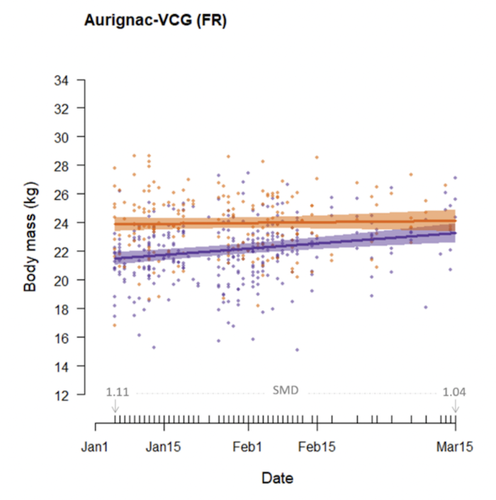
Body mass change over winter is consistently sex-specific across roe deer (Capreolus capreolus) populationsMark Hewison, Nadège Bonnot, Jean-Michel Gaillard, Petter Kjellander, Jean-François Lemaitre, Nicolas Morellet & Maryline Pellerin https://doi.org/10.1101/2022.09.09.507329Is it sexual mass dimorphism season?Recommended by Denis Réale based on reviews by Patrick Bergeron, Philip McLoughlin and Achaz von HardenbergPolygyny is assumed to have led to the evolution of strong sexual size dimorphism (SSD) in mammals, males often being heavier or showing more developed armaments than females (Weckerly 1998; Loison et al. 1999; Pérez‐Barbería et al. 2002). SSD generally increases with the degree of polygyny of the species. However, the degree of SSD, and particularly of sexual mass dimorphism, is not fixed for each species, and differences exist between populations (Blanckenhorn et al. 2006; Cox & Calsbeek 2010) or even between seasons within populations (Rughetti & Festa‐Bianchet 2011). In this study, Hewison et al. propose that studying seasonal variation in sexual mass dimorphism and how this can be affected by winter harshness and latitude allows us to better assess the energetic costs associated with the eco-evolutionary constraints acting on each sex. To achieve their goal, Hewison et al. use a formidable, long-term dataset of over 7,000 individuals, in five roe deer populations (Capreolus capreolus), from south-west France and Sweden. According to the authors, sexual mass dimorphism should be at its lowest in early spring in this species due to a stronger trade-off between antler growth and body weight maintenance in males over winter than in females. Furthermore, harsher conditions, varying both in time and space (i.e., Sweden vs. France), should increase winter weight loss, and thus, mass change differences between the sexes should be stronger and show more variation in Sweden than in France.
References Blanckenhorn, W. U., Stillwell, R. C., Young, K. A., Fox, C. W., & Ashton, K. G. (2006). When Rensch meets Bergmann: does sexual size dimorphism change systematically with latitude? Evolution, 60(10), 2004-2011. https://doi.org/10.1554/06-110.1 | Body mass change over winter is consistently sex-specific across roe deer (*Capreolus capreolus*) populations | Mark Hewison, Nadège Bonnot, Jean-Michel Gaillard, Petter Kjellander, Jean-François Lemaitre, Nicolas Morellet & Maryline Pellerin | <p>In most polygynous vertebrates, males must allocate energy to growing secondary sexual characteristics, such as ornaments or weapons, that they require to attract and defend potential mates, impacting body condition and potentially entailing fi... |  | Behaviour & Ethology, Life history | Denis Réale | 2022-09-16 15:41:53 | View | |
18 Sep 2024
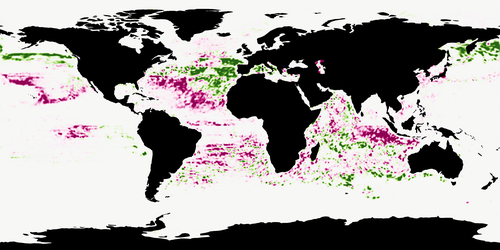
Predicting species distributions in the open ocean with convolutional neural networksGaétan Morand, Alexis Joly, Tristan Rouyer, Titouan Lorieul, Julien Barde https://doi.org/10.1101/2023.08.11.551418The potential of Convolutional Neural Networks for modeling species distributionsRecommended by François Munoz based on reviews by Jean-Olivier Irisson, Sakina-Dorothee Ayata and 1 anonymous reviewer based on reviews by Jean-Olivier Irisson, Sakina-Dorothee Ayata and 1 anonymous reviewer
Morand et al. (2024) designed convolutional neural networks to predict the occurrences of 38 marine animals worldwide. The environmental predictors were sea surface temperature, chlorophyll concentration, salinity and fifteen others. The time of some of the predictors was chosen to be as close as possible to the time of the observed occurrence. A very interesting feature of PCI Ecology is that reviews are provided with the final manuscript and the present recommendation text. The main question debated during the review process was whether the CNN modeling approach used here can be defined as a kind of niche modeling. Another interesting point is that the CNN model is used here as a multi-species classifier, meaning that it provides the ranked probability that a given observation corresponds to one of the 38 species considered in the study, depending on the environmental conditions at the location and time of the observation. In other words, the model provides the relative chance of choosing each of the 38 species at a given time and place. Imagine that you are only studying two species that have exactly the same niche, a standard SDM approach should provide a high probability of occurrence close to 1 in localities where environmental conditions are very and equally suited to both species, while the CNN classifier would provide a value close to 0.5 for both species, meaning that we have an equal chance of choosing one or the other. Consequently, the fact that the probability given by the classifier is higher for a species at a given point than at another point does not (necessarily) mean that the first point presents better environmental conditions for that species but rather that we are more likely to choose it over one of the other species at this point than at another. In fact, the classification task also reflects whether the other 37 species are more or less likely to be found at each point. The classifier, therefore, does not provide the relative probability of occurrence of a species in space but rather a relative chance of finding it instead of one of the other 37 species at each point of space and time. Finally, CNN-based species distribution modelling is a powerful and promising tool for studying the distributions of multi-species assemblages as a function of local environmental features but also of the spatial heterogeneity of each feature around the observation point in space and time (Deneu et al. 2021). It allows acknowledging the complex effects of environmental predictors and the roles of their spatial and temporal heterogeneity through the convolution operations performed in the neural network. As more and more computationally intensive tools become available, and as more and more environmental data becomes available at finer and finer temporal and spatial scales, the CNN approach is likely to be increasingly used to study biodiversity patterns across spatial and temporal scales. References Botella, C., Joly, A., Bonnet, P., Monestiez, P., and Munoz, F. (2018). Species distribution modeling based on the automated identification of citizen observations. Applications in Plant Sciences, 6(2), e1029. https://doi.org/10.1002/aps3.1029 Deneu, B., Servajean, M., Bonnet, P., Botella, C., Munoz, F., and Joly, A. (2021). Convolutional neural networks improve species distribution modelling by capturing the spatial structure of the environment. PLoS Computational Biology, 17(4), e1008856. https://doi.org/10.1371/journal.pcbi.1008856 Morand, G., Joly, A., Rouyer, T., Lorieul, T., and Barde, J. (2024) Predicting species distributions in the open ocean with convolutional neural networks. bioRxiv, ver.3 peer-reviewed and recommended by PCI Ecology https://doi.org/10.1101/2023.08.11.551418 Ovaskainen, O., Tikhonov, G., Norberg, A., Guillaume Blanchet, F., Duan, L., Dunson, D., ... and Abrego, N. (2017). How to make more out of community data? A conceptual framework and its implementation as models and software. Ecology letters, 20(5), 561-576. https://doi.org/10.1111/ele.12757 | Predicting species distributions in the open ocean with convolutional neural networks | Gaétan Morand, Alexis Joly, Tristan Rouyer, Titouan Lorieul, Julien Barde | <p>As biodiversity plummets due to anthropogenic disturbances, the conservation of oceanic species is made harder by limited knowledge of their distributions and migrations. Indeed, tracking species distributions in the open ocean is particularly ... |  | Marine ecology, Species distributions | François Munoz | Jean-Olivier Irisson | 2023-08-13 07:25:28 | View |
04 Sep 2024
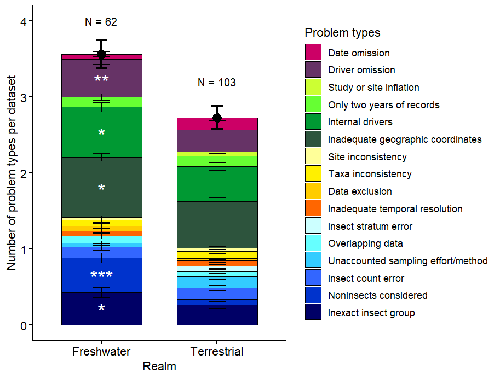
Why we need to clean the Augean stables of ecology – the case of InsectChangeRecommended by Francois Massol based on reviews by Bradley Cardinale and 1 anonymous reviewer based on reviews by Bradley Cardinale and 1 anonymous reviewer
As biodiversity has become a major global concern for a variety of stakeholders, and society in general, assessments of biodiversity trends at all spatial scales have flourished in the past decades. To assess trends, one needs data, and the more precise the data, the more precise the trend. Or, if precision is not perfect, uncertainty in the data must be acknowledged and accounted for. Such considerations have already been raised in ecology, most notably regarding the value of species distribution data to model the current and future distribution of species (Rocchini et al., 2011, Duputié et al., 2014, Tessarolo et al., 2021), leading to serious doubts regarding the value of public databases (Maldonado et al., 2015). And more recently similar issues have been raised regarding databases of species traits (Augustine et al., 2024), emphasizing the importance of good data practice and traceability. Science is by nature a self-correcting human process, with many steps of the scientific activity prone to errors and misinterpretations. Collation of ecological data, sadly, is proof of this. Spurred by the astonishing results of Hallmann et al. (2017) regarding the decline of insect biomass, and to more precisely answer the question of biodiversity trends in insects and settle an ongoing debate (Cardinale et al., 2018), van Klink et al. (2020, 2021) established the InsectChange database. Several perceptive comments have already been made regarding the possible issues in the methods and interpretations of this study (Desquilbet et al., 2020, Jähnig et al., 2021, Duchenne et al., 2022). However, the biggest issue might have been finally unearthed by Gaume & Desquilbet (2024): with poorly curated data, the InsectChange database is unlikely to support most of the initial claims regarding insect biodiversity trends. The compilation of errors and inconsistencies present in InsectChange and evinced by Gaume & Desquilbet (2024) is stunning to say the least, with a mix of field and experimental data combined without regard for experimental manipulation of environmental factors, non-standardised transformations of abundances, the use of non-insect taxa to compute insect trends, and inadequate geographical localizations of samplings. I strongly advise all colleagues interested in the study of biodiversity from global databases to consider the points raised by the authors, as it is quite likely that other databases might suffer from the same ailments as well. Reading this paper is also educating and humbling in its own way, since the publication of the original papers based on InsectChange seems to have proceeded without red flags from reviewers or editors. The need for publishing fast results that will make the next buzz, thus obeying the natural selection of bad science (Smaldino and McElreath, 2016), might be the systemic culprit. However, this might also be the opportunity ecology needs to consider the reviewing and curation of data as a crucial step of science quality assessment. To make final assessments, let us proceed with less haste. References Augustine, S. P., Bailey-Marren, I., Charton, K. T., Kiel, N. G. & Peyton, M. S. (2024) Improper data practices erode the quality of global ecological databases and impede the progress of ecological research. Global Change Biology, 30, e17116. https://doi.org/10.1111/gcb.17116 Cardinale, B. J., Gonzalez, A., Allington, G. R. H. & Loreau, M. (2018) Is local biodiversity declining or not? A summary of the debate over analysis of species richness time trends. Biological Conservation, 219, 175-183. https://doi.org/10.1016/j.biocon.2017.12.021 Desquilbet, M., Gaume, L., Grippa, M., Céréghino, R., Humbert, J.-F., Bonmatin, J.-M., Cornillon, P.-A., Maes, D., Van Dyck, H. & Goulson, D. (2020) Comment on “Meta-analysis reveals declines in terrestrial but increases in freshwater insect abundances”. Science, 370, eabd8947. https://doi.org/10.1126/science.abd8947 Duchenne, F., Porcher, E., Mihoub, J.-B., Loïs, G. & Fontaine, C. (2022) Controversy over the decline of arthropods: a matter of temporal baseline? Peer Community Journal, 2. https://doi.org/10.24072/pcjournal.131 Duputié, A., Zimmermann, N. E. & Chuine, I. (2014) Where are the wild things? Why we need better data on species distribution. Global Ecology and Biogeography, 23, 457-467. https://doi.org/10.1111/geb.12118 Gaume, L. & Desquilbet, M. (2024) InsectChange: Comment. biorXiv, ver.4 peer-reviewed and recommended by PCI Ecology https://doi.org/10.1101/2023.06.17.545310 Hallmann, C. A., Sorg, M., Jongejans, E., Siepel, H., Hofland, N., Schwan, H., Stenmans, W., Müller, A., Sumser, H., Hörren, T., Goulson, D. & de Kroon, H. (2017) More than 75 percent decline over 27 years in total flying insect biomass in protected areas. PLOS ONE, 12, e0185809. https://doi.org/10.1371/journal.pone.0185809 Jähnig, S. C., Baranov, V., Altermatt, F., Cranston, P., Friedrichs-Manthey, M., Geist, J., He, F., Heino, J., Hering, D., Hölker, F., Jourdan, J., Kalinkat, G., Kiesel, J., Leese, F., Maasri, A., Monaghan, M. T., Schäfer, R. B., Tockner, K., Tonkin, J. D. & Domisch, S. (2021) Revisiting global trends in freshwater insect biodiversity. WIREs Water, 8, e1506. https://doi.org/10.1002/wat2.1506 Maldonado, C., Molina, C. I., Zizka, A., Persson, C., Taylor, C. M., Albán, J., Chilquillo, E., Rønsted, N. & Antonelli, A. (2015) Estimating species diversity and distribution in the era of Big Data: to what extent can we trust public databases? Global Ecology and Biogeography, 24, 973-984. https://doi.org/10.1111/geb.12326 Rocchini, D., Hortal, J., Lengyel, S., Lobo, J. M., Jiménez-Valverde, A., Ricotta, C., Bacaro, G. & Chiarucci, A. (2011) Accounting for uncertainty when mapping species distributions: The need for maps of ignorance. Progress in Physical Geography, 35, 211-226. https://doi.org/10.1177/0309133311399491 Smaldino, P. E. & McElreath, R. (2016) The natural selection of bad science. Royal Society Open Science, 3. https://doi.org/10.1098/rsos.160384 Tessarolo, G., Ladle, R. J., Lobo, J. M., Rangel, T. F. & Hortal, J. (2021) Using maps of biogeographical ignorance to reveal the uncertainty in distributional data hidden in species distribution models. Ecography, 44, 1743-1755. https://doi.org/10.1111/ecog.05793 van Klink, R., Bowler, D. E., Comay, O., Driessen, M. M., Ernest, S. K. M., Gentile, A., Gilbert, F., Gongalsky, K. B., Owen, J., Pe'er, G., Pe'er, I., Resh, V. H., Rochlin, I., Schuch, S., Swengel, A. B., Swengel, S. R., Valone, T. J., Vermeulen, R., Wepprich, T., Wiedmann, J. L. & Chase, J. M. (2021) InsectChange: a global database of temporal changes in insect and arachnid assemblages. Ecology, 102, e03354. https://doi.org/10.1002/ecy.3354 van Klink, R., Bowler, D. E., Gongalsky, K. B., Swengel, A. B., Gentile, A. & Chase, J. M. (2020) Meta-analysis reveals declines in terrestrial but increases in freshwater insect abundances. Science, 368, 417-420. https://doi.org/10.1126/science.aax9931 | InsectChange: Comment | Laurence Gaume, Marion Desquilbet | <p>The InsectChange database (van Klink et al. 2021) underlying the meta-analysis by van Klink et al. (2020a) compiles worldwide time series of the abundance and biomass of invertebrates reported as insects and arachnids, as well as ecological dat... |  | Biodiversity, Climate change, Freshwater ecology, Landscape ecology, Meta-analyses, Species distributions, Terrestrial ecology, Zoology | Francois Massol | 2024-01-04 18:57:01 | View | |
29 Aug 2024
Flexible reproductive seasonality in Africa-dwelling papionins is associated with low environmental productivity and high climatic unpredictabilityJules Dezeure, Julie Dagorrette, Lugdiwine Burtschell, Shahrina Chowdhury, Dieter Lukas, Larissa Swedell, Elise Huchard https://doi.org/10.1101/2024.05.01.591991Reproductive flexibility shapes primate survival in a changing climate driven by environmental unpredictabilityRecommended by Cédric Sueur based on reviews by 2 anonymous reviewers based on reviews by 2 anonymous reviewers
As seasonal cycles become increasingly disrupted, our understanding of the ecology and evolution of reproductive seasonality in tropical vertebrates remains limited (Bronson 2009). To predict how changes in seasonality might impact these animals, it is crucial to identify which elements of their varied reproductive patterns are connected to the equally varied patterns of rainfall seasonality (within-year fluctuations) or the significant climatic unpredictability (year-to-year variations) characteristic of the intertropical region. Dezeure et al. (2024) provide a comprehensive examination of reproductive seasonality in papionin monkeys across diverse African environments. By investigating the ecological and evolutionary determinants of reproductive timing, the authors offer novel insights into how climatic factors, particularly environmental unpredictability, shape reproductive strategies in these primates. This study stands out not only for its methodological rigour but also for its contribution to our understanding of how primates adapt their reproductive behaviours to varying environmental pressures. The findings have broad implications, particularly in the context of ongoing climate change, which is expected to increase environmental unpredictability globally. The innovative approach of this paper lies in its multifaceted examination of reproductive seasonality, which integrates data from 21 wild populations of 11 papionin species. The study employs a robust statistical framework, incorporating Bayesian phylogenetic generalised linear mixed models to control for phylogenetic relatedness among species. This methodological choice is crucial because it allows the authors to disentangle the effects of environmental variables from evolutionary history, providing a more accurate picture of how current ecological factors influence reproductive strategies. The study’s focus on environmental unpredictability as a determinant of reproductive seasonality is particularly noteworthy. While previous research has established the importance of environmental seasonality (Janson and Verdolin 2005), this paper breaks new ground by showing that the magnitude of year-to-year variation in rainfall – rather than just the seasonal distribution of rainfall – plays a critical role in determining the intensity of reproductive seasonality. This finding is supported by the significant negative correlation between reproductive seasonality and environmental unpredictability, which the authors demonstrate across multiple populations and species. The results of this study are important for several reasons. First, they challenge the traditional view that reproductive seasonality is primarily driven by within-year environmental fluctuations. By showing that inter-annual variability in rainfall is a stronger predictor of reproductive timing than intra-annual variability, the authors suggest that primates, like papionins, have evolved flexible reproductive strategies to cope with the unpredictable availability of resources. This flexibility is likely an adaptive response to the highly variable environments that many African primates inhabit, where food availability can vary dramatically not just within a year but from year to year. Second, the study highlights the role of reproductive flexibility in the evolutionary success of papionins. The authors provide compelling evidence that species within the Papio genus, for example, exhibit significant variability in reproductive timing both within and between populations. This variability suggests that these species possess a remarkable ability to adjust their reproductive strategies in response to local environmental conditions, which may have contributed to their widespread distribution across diverse habitats in Africa. This finding aligns with the work of Brockman and Schaik (2005), who argued that reproductive flexibility is a key factor in the success of primates in unpredictable environments. The study also contributes to our understanding of the evolutionary transition from seasonal to non-seasonal breeding in primates. The authors propose that the loss of strict reproductive seasonality in some papionin species may represent an adaptive shift toward greater reproductive flexibility. This shift could be driven by the need to maximise reproductive success in environments where the timing of resource peaks is difficult to predict. The authors’ findings support this hypothesis, as they show that populations living in more unpredictable environments tend to have lower reproductive seasonality. The broader implications of this study (Dezeure et al. 2024) extend beyond the specific case of papionin monkeys. The findings have relevance for the study of reproductive strategies in other long-lived, tropical mammals that face similar environmental challenges. As climate change is expected to increase the frequency and intensity of environmental unpredictability, understanding how species have historically adapted to such conditions can provide valuable insights into their potential resilience or vulnerability to future changes. Many primate species are already facing significant threats from habitat loss, hunting, and climate change. By identifying the environmental factors that influence reproductive success, Dezeure et al. (2024) study can help inform conservation strategies aimed at protecting the most vulnerable populations. For example, conservation efforts could focus on maintaining or restoring habitat features that promote reproductive flexibility, such as access to a variety of food resources that peak at different times of the year (Chapman et al.). References Brockman D, Schaik C (2005) Seasonality in Primates: Studies of Living and Extinct Human and Non-Human Primates. Cambridge University Press. https://doi.org/10.1017/CBO9780511542343 Bronson FH (2009) Climate change and seasonal reproduction in mammals. Philos Trans R Soc B Biol Sci 364:3331–3340. https://doi.org/10.1098/rstb.2009.0140 Chapman CA, Gogarten JF, Golooba M, et al Fifty+ years of primate research illustrates complex drivers of abundance and increasing primate numbers. Am J Primatol n/a:e23577. https://doi.org/10.1002/ajp.23577 Jules Dezeure, Julie Dagorrette, Lugdiwine Burtschell, Shahrina Chowdhury, Dieter Lukas, Larissa Swedell, Elise Huchard (2024) Flexible reproductive seasonality in Africa-dwelling papionins is associated with low environmental productivity and high climatic unpredictability. bioRxiv, ver.2 peer-reviewed and recommended by PCI Ecology https://doi.org/10.1101/2024.05.01.591991 Janson C, Verdolin J (2005) Seasonality of primate births in relation to climate. In: Schaik CP van, Brockman DK (eds) Seasonality in Primates: Studies of Living and Extinct Human and Non-Human Primates. Cambridge University Press, Cambridge, pp 307–350 https://doi.org/10.1017/CBO9780511542343.012 | Flexible reproductive seasonality in Africa-dwelling papionins is associated with low environmental productivity and high climatic unpredictability | Jules Dezeure, Julie Dagorrette, Lugdiwine Burtschell, Shahrina Chowdhury, Dieter Lukas, Larissa Swedell, Elise Huchard | <p style="text-align: justify;">At a time when seasonal cycles are increasingly disrupted, the ecology and evolution of reproductive seasonality in tropical vertebrates remains poorly understood. In order to predict how changes in seasonality migh... | Behaviour & Ethology, Evolutionary ecology, Zoology | Cédric Sueur | 2024-05-04 18:57:25 | View | ||
26 Aug 2024
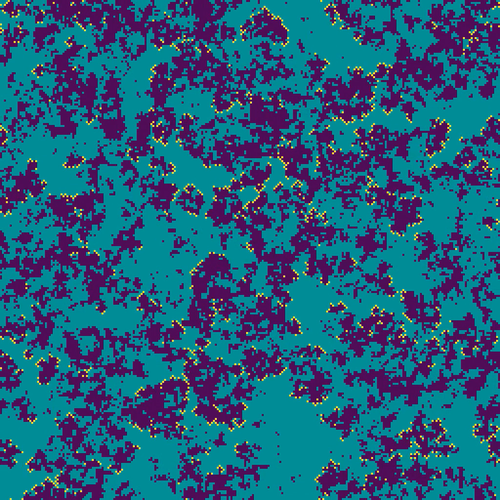
Easy, fast and reproducible Stochastic Cellular Automata with choucaAlexandre Génin, Guillaume Dupont, Daniel Valencia, Mauro Zucconi, M. Isidora Ávila-Thieme, Sergio A. Navarrete, Evie A. Wieters https://doi.org/10.1101/2023.11.08.566206An R package for flexible and fast Stochastic Cellular Automata modelingRecommended by Samuel Alizon based on reviews by Broder Breckling and 1 anonymous reviewer based on reviews by Broder Breckling and 1 anonymous reviewer
Stochastic Cellular Automata (SCA) are a popular modelling tool because in, spite of their simplicity, they can generate a variety of spatial patterns. This makes them particularly appreciated, for instance, to validate the insights of analytical or semi-analytical spatial models that make simplifying assumptions, e.g. moment equations models. A first limit to SCA are that as soon as details are added to the model, reproducibility issues may occur. Computation speed is also an issue, especially for large populations. The work by Génin et al. addresses these two issues through the development of an R package, chouca. The use of the package is designed to be as smooth as possible: users only need to define the type of possible transitions along with their rates, the parameter values, the number of neighbours, and the initial state of the landscape. The main function returns the population dynamics of each state and even the final state of the landscape. In addition to its flexibility, an asset of chouca resides in its use of the Rcpp package, which compiles the model designed by the user in C++. This allows for high computation speed, which can be further boosted by using parallelising options from R. In their manuscript, the authors use ecological models to illustrate the more advanced possibilities opened by chouca, e.g. in terms of graphical interpretation or even to estimate parameter values by computing likelihood functions (the implementation in R does make it very appropriate for statistical inference in general). The package still has some limitations, and, for example, it currently only applied to 2D rectangular grids and it cannot include elaborate movement processes. However, some of these could be addressed in future releases and chouca already has the potential to become central for SCA modelling, both for beginners and expert users, especially in ecology. References Alexandre Génin, Guillaume Dupont, Daniel Valencia, Mauro Zucconi, M. Isidora Ávila-Thieme, Sergio A. Navarrete, Evie A. Wieters (2024) Easy, fast and reproducible Stochastic Cellular Automata with chouca. bioRxiv, ver.6 peer-reviewed and recommended by Peer Community in Ecology https://doi.org/10.1101/2023.11.08.566206 | Easy, fast and reproducible Stochastic Cellular Automata with chouca | Alexandre Génin, Guillaume Dupont, Daniel Valencia, Mauro Zucconi, M. Isidora Ávila-Thieme, Sergio A. Navarrete, Evie A. Wieters | <p style="text-align: justify;">Stochastic cellular automata (SCA) are models that describe spatial dynamics using a grid of cells that switch between discrete states over time. They are widely used to understand how small-scale processes scale up... |  | Community ecology, Landscape ecology, Spatial ecology, Metacommunities & Metapopulations, Statistical ecology, Theoretical ecology | Samuel Alizon | 2024-03-11 10:54:39 | View | |
26 Aug 2024
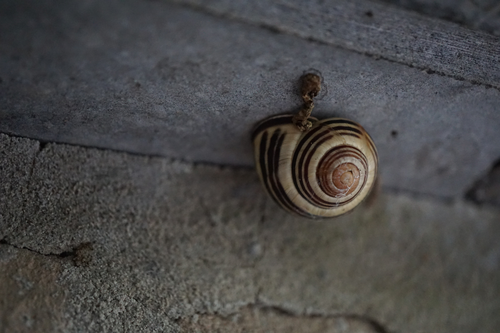
Urban Cepaea nemoralis snails are less likely to have nematodes trapped within their shellsMaxime Dahirel, Hannah Reyné, Katrien De Wolf, Dries Bonte https://doi.org/10.1101/2024.03.07.583959Urbanisation linked to a decline in the proportion of snails with trapped nematodes in their shellRecommended by Alison Duncan based on reviews by Robbie Rae and 1 anonymous reviewerUrbanisation modifies species’ habitats affecting their density, distribution, fitness, and behaviour with knock-on effects for their parasites’ abundance and transmission (Bradley & Altizer 2007). A meta-analysis found that changes in resource provisioning due to anthropogenic change can have both positive and negative effects on parasite infection in wildlife populations, but that feeding on urban waste had an effect of reducing infection, especially for helminths and protozoa (Becker, Streicker & Altizer 2015). Another study found that urbanisation reduced ectoparasite load in birds, but had no effect on endoparasites or avian flu (Reid et al. 2024). These changes may be due to novel diets reducing transmission via predation upon trophic hosts (Becker, Streicker & Altizer 2015) or behavioural, leading to more time available to preen (Reid et al. 2024). Less is known about how urbanisation affects invertebrates (but see Lewthwaite et al., 2024) and their parasites. This is important considering that invertebrates are often intermediate hosts of, and/or vector other parasites. Recent work has found that snails and slugs can trap nematodes in their shells to prevent infection (Rae 2017). This newly discovered resistance mechanism reveals that the shell serves an immune defence function. It also provides a record of nematode exposure and documents incidences of resistance to infection as the trapped nematode becomes fixed onto the shell surface (Rae 2017). Dahirel and co-authors exploit this to investigate whether snail-nematode interactions change in response to increasing levels of urbanisation (Dahirel et al. 2024). They explore whether the proportion of Cepaea nemoralis snails with trapped nematodes in their shell changes across an urbanisation gradient. They also explore whether different phenotypic snail traits, notably shell size, colour, band number and fusion explain the likelihood of having trapped nematodes in their shells. An increase in urbanisation was associated with a decrease in the proportion of snails with trapped nematodes in their shells. At the same time larger shells were more likely to have trapped nematodes, but this effect did not change across the urbanisation gradient. The authors discuss that reduced nematode encapsulation in urban environments may be due to lower encounter rate due to either fewer nematodes in urban environments, changes in snail behaviour reducing exposure, or alternatively that urban snails were less resistant to nematode infection. It will be interesting to investigate how this resistance mechanism is related to other forms of snail immunity and whether high rates of nematode encapsulation are an indicator of high resistance or high exposure. This will enable nematode trapping to be used as a marker to indicate environments and/or snail populations harbouring high levels of parasitism and further exploitation of museum collections to understand host-parasite interactions in the past (Rae 2017). References Becker, D.J., Streicker, D.G. & Altizer, S. (2015) Linking anthropogenic resources to wildlife-pathogen dynamics: a review and meta-analysis. Ecol Lett, 18, 483-495. https://doi.org/10.1111/ele.12428 Bradley, C.A. & Altizer, S. (2007) Urbanization and the ecology of wildlife diseases. Trends Ecol Evol, 22, 95-102. https://doi.org/10.1016/j.tree.2006.11.001 Maxime Dahirel, Hannah Reyné, Katrien De Wolf, Dries Bonte (2024) Urban Cepaea nemoralis snails are less likely to have nematodes trapped within their shells. bioRxiv, ver.4 peer-reviewed and recommended by PCI Ecology https://doi.org/10.1101/2024.03.07.583959 Lewthwaite, J.M.M., Baiotto, T.M., Brown, B.V., Cheung, Y.Y., Baker, A.J., Lehnen, C., McGlynn, T.P., Shirey, V., Gonzalez, L., Hartop, E., Kerr, P.H., Wood, E. & Guzman, L.M. (2024) Drivers of arthropod biodiversity in an urban ecosystem. Sci Rep, 14, 390. https://doi.org/10.1038/s41598-023-50675-3 Rae, R. (2017) The gastropod shell has been co-opted to kill parasitic nematodes. Sci Rep, 7, 4745. https://doi.org/10.1038/s41598-017-04695-5 Reid, R., Capilla-Lasheras, P., Haddou, Y., Boonekamp, J. & Dominoni, D.M. (2024) The impact of urbanization on health depends on the health metric, life stage and level of urbanization: a global meta-analysis on avian species. Proc Biol Sci, 291, 20240617. https://doi.org/10.1098/rspb.2024.0617 | Urban *Cepaea nemoralis* snails are less likely to have nematodes trapped within their shells | Maxime Dahirel, Hannah Reyné, Katrien De Wolf, Dries Bonte | <p style="text-align: justify;">Urbanisation is a major human-induced environmental change which can impact not only individual species, but also the way these species interact with each other. As a group, terrestrial molluscs interact frequently ... |  | Host-parasite interactions, Human impact | Alison Duncan | 2024-03-11 11:35:15 | View | |
20 Aug 2024
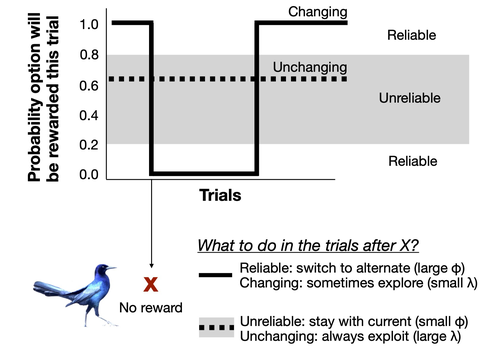
Bayesian reinforcement learning models reveal how great-tailed grackles improve their behavioral flexibility in serial reversal learning experimentsDieter Lukas, Kelsey B. McCune, Aaron P. Blaisdell, Zoe Johnson-Ulrich, Maggie MacPherson, Benjamin M. Seitz, Augustus Sevchik, Corina J. Logan https://doi.org/10.32942/osf.io/4ycpsChanges in behavioral flexibility to cope with environment instability: theoretical and empirical insights from serial reversal learning experimentsRecommended by Aurélie Coulon based on reviews by Maxime Dahirel and 1 anonymous reviewer based on reviews by Maxime Dahirel and 1 anonymous reviewer
Behavioral flexibility, i.e. the “ability to adapt behavior to new circumstances through packaging information and making it available to other cognitive processes” (Logan et al. 2023), appears as one of the crucial elements of responses of animal species to changing environments. Behavioral flexibility can change within the life of individuals, depending on their experience on the degree of variability and predictability of their surrounding environment. But little is known on the cognitive processes involved in these temporal changes in behavioral flexibility within individuals. This is what Lukas et al. (2024) investigated very thoroughly, using the framework of serial reversal learning experiments on great-tailed grackles to study different aspects of the question. Behavioral flexibility as involved in serial reversal learning experiments was previously modeled as being made of two primary parameters: the rate of updating associations, phi (i.e. how fast individuals learn the associations between a cue and its associated reward or danger); and the sensitivity to the learned associations, lambda (i.e. how strong do individuals make their choices based on the associations they learned). Lukas et al. (2024)* used a Bayesian reinforcement model to infer phi and lambda in individuals going through serial reversal learning experiments, to understand which of these two parameters explains most of the variation in grackle performance in serial reversal learning, how correlated they are, how they can change along time depending on an individual’s experience, how variable they can be among individuals, and whether they can predict performance in other contexts. But beforehand, the authors used an individual-based model to assess the ability of the Bayesian reinforcement model to correctly assess phi and lambda in their experimental design. They also used the Bayesian model to infer the range of values of phi and lambda an individual needs to exhibit to reduce errors in the serial reversal learning experiment. Among other results, this study shows that in a context of rapidly changing but strongly reliable cues, the variation in the success of grackles is more associated with the rate of updating associations (phi) than the sensitivity to learned associations (lambda). Besides, phi increased within individuals along the serial reversal learning experiment, while lambda only slightly decreased. However, it is very interesting to note that different approaches could be adopted by different individuals through the training, leading them eventually to the same final performance: slightly different combinations of changes in lambda and phi lead to different behaviours but compensate each other in the end in the final success rate. References Coulon, A. (2019) Can context changes improve behavioral flexibility? Towards a better understanding of species adaptability to environmental changes. Peer Community in Ecology, 100019. https://doi.org/10.24072/pci.ecology.100019 Logan, CJ, Lukas D, Bergeron L, Folsom M, McCune, K. (2019). Is behavioral flexibility related to foraging and social behavior in a rapidly expanding species? In Principle Acceptance by PCI Ecology of the Version on 6 Aug 2019. http://corinalogan.com/Preregistrations/g_flexmanip.html Dieter Lukas, Kelsey B. McCune, Aaron P. Blaisdell, Zoe Johnson-Ulrich, Maggie MacPherson, Benjamin M. Seitz, Augustus Sevchik, Corina J. Logan (2024) Bayesian reinforcement learning models reveal how great-tailed grackles improve their behavioral flexibility in serial reversal learning experiments. ecoevoRxiv, ver.4 peer-reviewed and recommended by Peer Community in Ecology https://doi.org/10.32942/osf.io/4ycps | Bayesian reinforcement learning models reveal how great-tailed grackles improve their behavioral flexibility in serial reversal learning experiments | Dieter Lukas, Kelsey B. McCune, Aaron P. Blaisdell, Zoe Johnson-Ulrich, Maggie MacPherson, Benjamin M. Seitz, Augustus Sevchik, Corina J. Logan | <p>Environments can change suddenly and unpredictably and animals might benefit from being able to flexibly adapt their behavior through learning new associations. Serial (repeated) reversal learning experiments have long been used to investigate ... |  | Behaviour & Ethology, Phenotypic plasticity, Preregistrations, Zoology | Aurélie Coulon | 2022-08-15 21:04:14 | View | |
16 Aug 2024
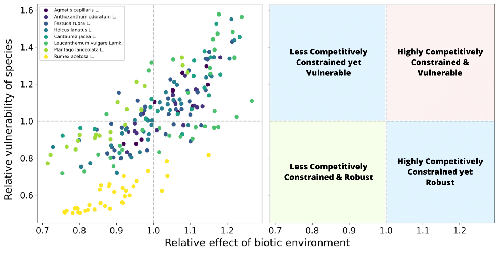
The distribution of distances to the edge of species coexistenceMario Desallais, Michel Loreau, Jean-François Arnoldi https://doi.org/10.1101/2024.01.21.575550How environmental perturbations affect coexistenceRecommended by Frederik De Laender based on reviews by Thomas Guillemaud, Oscar Godoy, Pablo Lechon and 1 anonymous reviewer Understanding the effects of environmental perturbations on coexistence is a key challenge in ecology, and models have played an important role in structuring our ideas and generating predictions, leading to quantitative hypotheses. In such models, environmental perturbations are often captured by changes in parameter values, such as the intrinsic growth rates of species (1–3). The question then becomes how much one can change these parameters without breaking coexistence and thus losing species (4). References 1. Baert, J.M., Janssen, C.R., Sabbe, K., and De Laender, F. (2016). Per capita interactions and stress tolerance drive stress-induced changes in biodiversity effects on ecosystem functions. Nat. Commun. 7, 12486. https://doi.org/10.1038/ncomms12486 8. Desallais M, Loreau M, Arnoldi J.F. (2024) The distribution of distances to the edge of species coexistence. bioRxiv, ver.4 peer-reviewed and recommended by PCI Ecology https://doi.org/10.1101/2024.01.21.575550 | The distribution of distances to the edge of species coexistence | Mario Desallais, Michel Loreau, Jean-François Arnoldi | <p>In Lotka-Volterra community models, given a set of biotic interactions, recent approaches have analysed the probability of finding a set of species intrinsic growth rates (representing intraspecific demographic features) that will allow coexist... |  | Coexistence, Community ecology, Competition, Facilitation & Mutualism, Interaction networks, Theoretical ecology | Frederik De Laender | 2024-02-15 14:17:32 | View |
MANAGING BOARD
Julia Astegiano
Tim Coulson
Anna Eklof
Dominique Gravel
François Massol
Ben Phillips
Cyrille Violle










